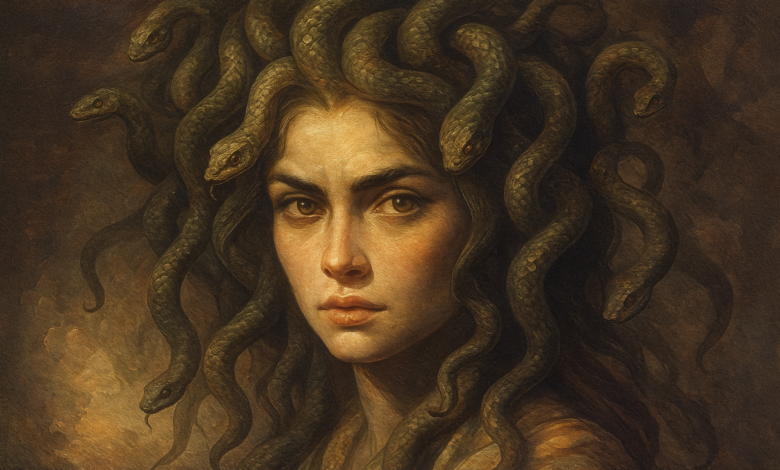Medusa Story: The Definitive Retelling and What It Means Today

A fresh, human-centered retelling of the Medusa story—where it began, how it changed, and why it still matters. Includes a clear timeline, character map, and FAQs.
Quick Summary
The Medusa story centers on a woman transformed into a Gorgon with living serpents for hair, whose gaze turns onlookers to stone. A hero, Perseus, later beheads her using a mirrored shield. Across versions, Medusa shifts from monster to victim to protector. This guide explains her earliest roots, how the tale evolved, and why her image remains one of the most potent symbols in culture.
Origins of the Medusa Story
Medusa belongs to the world of early Greek myth. In initial mentions, she appears among monstrous beings at the edges of the known world. Over time, storytellers enriched the narrative: some emphasized divine punishments and temple transgressions; others focused on the hero’s quest; later interpretations reframed Medusa as a powerful figure whose tragedy reveals more about the society that condemned her than about her own nature.
Two root ideas shape the myth:
- Transformation: Medusa’s change from mortal maiden to Gorgon represents sudden loss of status, safety, or beauty—and the birth of defiance.
- The Gaze: Her petrifying stare embodies the power of looking and being looked at: danger, judgment, and the refusal to be objectified.
Major Versions and How They Differ
There isn’t just one Medusa story. The details pivot around three axes: origin, blame, and outcome.
1) Origin
- Born monstrous: Medusa is one of three Gorgon sisters, inherently terrifying.
- Made monstrous: Medusa begins as a mortal whose beauty provokes divine envy or is harmed by a god; the transformation is a punishment or a grim defense.
2) Blame
- Transgression narrative: She trespasses in a sacred space or is punished for pride.
- Victim narrative: She suffers harm and is transformed not for guilt, but as a testimony to injustice.
3) Outcome
- Heroic trophy: Perseus slays Medusa to prove valor, using her head as a weapon.
- Enduring protector: Even after death, the Gorgon’s head shields the vulnerable—its image wards off evil.
Understanding these branches helps you read any retelling: each chooses origins, assigns blame, and decides whether Medusa’s legacy is terror or protection.
Key Characters and Their Motives
- Medusa: At various times maiden, monster, mother, and symbol. She stands at the crossroads of beauty and danger, victimhood and power.
- Athena: Goddess of strategy and craft; her role vacillates between punisher, rival, and steward of Medusa’s lingering power.
- Perseus: The hero whose quest depends on cunning as much as courage; he navigates the danger of Medusa’s gaze with reflection, shadow, and speed.
- Poseidon: A catalyst in certain versions, tied to the temple encounter that triggers Medusa’s transformation.
- The Gorgon Sisters: Stheno and Euryale, who embody the idea that no one is monstrous alone—family and origin shape fate.
A Fresh Retelling of the Medusa Story
Before the sea foam quieted and the gulls finished their morning arguments, the temple was already awake. The marble held the night’s cool breath; the lamps blinked, searching for the first worshipper. Medusa passed through the outer court with the unhurried steps of someone who knew the place well. She carried nothing—no oil, no ribbon, no fruit. Only a small resolve, tucked into her chest: to step inside as she was, not as others insisted she be.
Some in the city whispered about her hair, how it refused to lie flat, how even a scarf could not quite tame it. They said the gods watched her. They said the world did, too. Medusa had learned the difference between curiosity and hunger, between praise and possession.
What happened in the shadows would be told a hundred ways. In some tellings, a god arrived like a sudden storm, and the temple changed from sanctuary to court. In others, there was only a rumor, a single moment of trespass seized upon by those who needed a reason to correct a woman who did not bow.
Athena found her there. The goddess’s face did not show anger at first—only a tightness around the mouth, the expression of a craftswoman who sees a warp in the fabric. What came next was not a simple curse but a reweaving. The hair coiled, alive. The skin learned a new language. The eyes, practiced by years of fending off looks, became looks that could fend off anything.
They called her monster, because the word is easy. But on the island where the sisters dwelt, Medusa learned that fear could be a shelter if you owned it. Travelers came less often. Those who did lingered on the edge of the shore, unsure whether to pray or flee. She learned to soften her gaze at sunrise and harden it at dusk. She learned the measure of mercy: to turn away before someone else turned to stone.
Perseus did not arrive as a thunderbolt, but as a careful shadow. He had been told to be brave; instead, he was clever. He lifted a polished shield not to dazzle, but to look indirectly, to refuse the simple choice of seeing or being seen. In the mirrored surface, Medusa recognized a familiar tactic. Hadn’t she been living in reflections—other people’s versions of her—for years?
The moment the blade found her, the world paused. From the severed neck sprang impossible life—a winged horse and a giant, promises hidden in catastrophe. Even her death insisted on creation. Perseus took the head and fled. The island exhaled. The sisters wailed. Somewhere far above, a goddess considered the price of justice measured in symbols instead of solace.
In time, the Gorgon’s head would ride on shields and gates, scaring away evil, or perhaps only reminding onlookers that evil often comes disguised. Athena would carry it not as a trophy, but as an admission: that power taken wrongly asks to be re-used rightly, that the thing we fear may also be the thing that protects us.
And Medusa? She remained, in a thousand replications, never entirely dead. In markets and halls and thresholds, her face insisted on eye contact. Do not pretend you do not see, it said. Do not pretend I do not see you.
Symbols, Meanings, and Themes
The Gaze
Turning to stone is more than death—it is the fate of being frozen by judgment. Medusa’s gaze reverses the usual order: the watcher becomes the one watched, and power shifts.
Beauty and Blame
In versions where Medusa begins as a celebrated beauty, the story questions cultures that make beauty a prize and a liability. The transformation exposes how quickly admiration becomes punishment.
Weapon and Ward
Medusa’s head is both a weapon and a protective emblem. The duality suggests that what terrifies us can be rechanneled into defense, and that symbols survive their creators.
Creation from Catastrophe
The birth of new beings at the moment of Medusa’s death speaks to transformation through rupture: endings that are also beginnings.
Timeline of the Myth
- Early mentions: Medusa appears among monstrous beings at the world’s margins.
- Transformative turn: Stories emerge of a mortal woman altered by a goddess, shifting blame and sympathy.
- Hero’s quest: Perseus seeks the Gorgon using cunning tools—mirror, speed, stealth.
- Death and aftermath: Beheading yields new life; the Gorgon’s head continues to act in the world.
- Enduring symbol: The face persists as a guardian image on armor, doors, and art.
Common Misreadings and How to Avoid Them
- Only a monster: Reduces the tale to a fight scene. Fix: Include origin, motive, and aftermath.
- Only a victim: Erases her agency. Fix: Show how she adapts and protects, even in exile.
- Only the hero’s story: Centers the quest but misses the symbol. Fix: Trace how the head functions after death.
- Flat timeline: Treats all sources as identical. Fix: Acknowledge differing versions and what each emphasizes.
Medusa in the Modern World
Today the Medusa story signals boundary-setting and hard-won autonomy. Her image appears when people refuse to be reduced to trophies or warnings. As a metaphor, she asks a persistent question: When we call someone a monster, whose fear are we protecting?
FAQs
What is the Medusa story in simple terms?
It’s the tale of a woman transformed into a Gorgon whose gaze turns others to stone, later slain by Perseus. Across versions, she is monster, victim, and protector—often all three.
Was Medusa always a monster?
No. Some versions make her monstrous by birth, others show a mortal transformed after a violation or divine conflict. Each version changes how we judge her.
Why does Medusa’s gaze turn people to stone?
Symbolically, it reverses objectification: those who would fix her in place become fixed themselves. It is the power to refuse someone else’s controlling gaze.
What happens after Perseus beheads Medusa?
New life emerges from tragedy, and the Gorgon’s head continues to act in the world as a potent emblem—both weapon and ward.
What does Medusa represent today?
She represents transformation, self-protection, and the contested politics of beauty and blame. Her face challenges easy categories of hero and monster.
Conclusion
The Medusa story endures because it is more than a mythic duel; it is a study in power—who has it, how it’s used, and what happens when symbols outlast their makers. Read one way, Medusa is terror. Read another, she is a mirror. In either case, she teaches that what we fear can harden us—or protect us—depending on how we choose to see.





